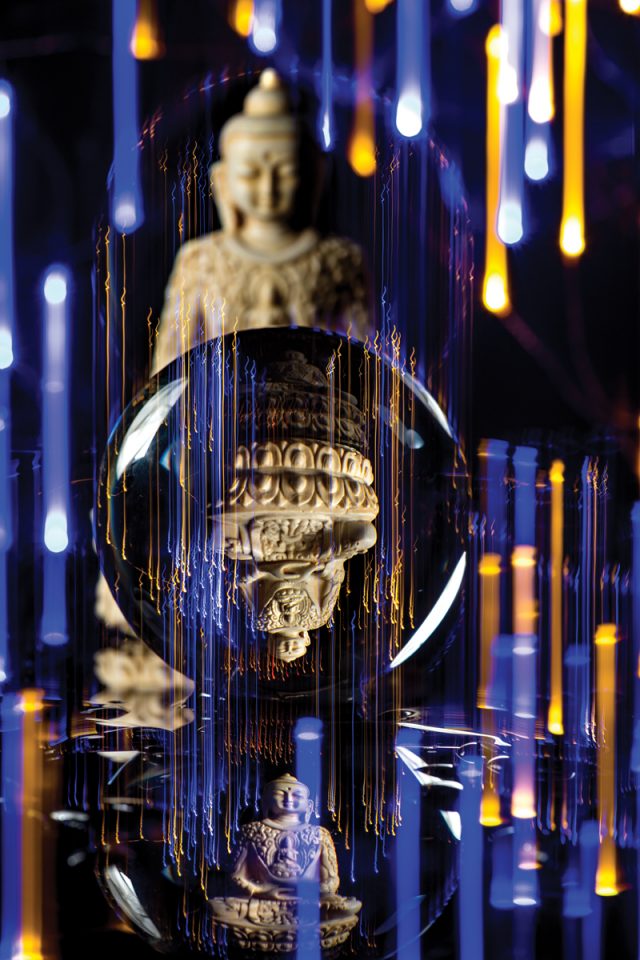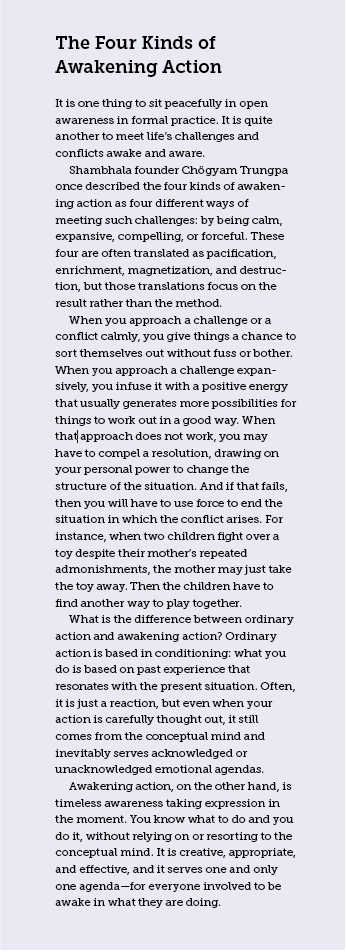“Do Western women really believe that they are breaking samaya if they don’t sleep with their teacher?”
I was taken aback by the question, posed by one of two Tibetan teachers I was talking with at a conference.
“Well,” I replied, “they probably do. After all, you are the teachers. You taught them that samaya means obedience to the guru and that sacred outlook means seeing the teacher as a buddha.”
“You have so much education,” he said, rolling his eyes. “How can you take that so literally?”
Appalled, I looked at the other lama. He just sat there, trying not to snigger.
I have had the good fortune to study and practice Vajrayana in the Tibetan tradition of Buddhism for more than a few years. Despite the sometimes yawning chasms in culture and thinking, I have come to appreciate the power and depth of samaya and sacred outlook as tools of practice. At the same time, I am dismayed at the way these tools have been exploited for individual and institutional agendas. In this article, my aim is to clarify what these tools are and how they work.
People engage in spiritual practice for different reasons. Some people practice to make their lives better by developing new skills or healing old wounds. Some want to participate in a community of people who share a common outlook on matters of the spirit—a congregation, or in Buddhist terms, a sangha. And for a few, spiritual practice is a response to a mystical calling to some kind of direct experience.
Practically speaking, all three motivations operate in most of us. Who wouldn’t like to function better in their lives? We are also social animals and enjoy the company of like-minded people. And, if you are reading this article, there is probably a mystic lurking somewhere in you. By a mystic, I mean someone who seeks a way to experience life that is not mediated by the conceptual mind.
Each of these motivations gives rise to a different set of behavioral guidelines. In the first case, the ethical principles are usually similar to those set for other professionals, such as therapists or doctors. In the second, agreed-upon values give rise to a shared moral sense that determines not only what behaviors are or are not acceptable but also who does or does not belong to the community. As for the mystic, it is hard to lay down clear guidelines, just as it is hard to do so for the arts, or for any practice or discipline that challenges social and cultural conventions. In this article, I am writing for the mystic in you, the part of you that seeks a direct experiential knowing of life, the universe, and who or what we are.
In the Vajrayana traditions of Buddhism, samaya and sacred outlook are two tools of practice that speak to that mystical calling. Misunderstandings abound here, particularly in the area of the teacher-student relationship.
Related: Shambhala Leaders Step Down after Abuse Allegations Shake Community
Samaya is the Sanskrit word for commitment. In a Vajrayana context, samaya is our commitment to awakening—to experiencing life directly, free from the projections of thought and feeling. It is also our commitment to use whatever we encounter in life to further that awakening. It has many facets: our commitment to our teachers, our students and our peers, our commitment to the forms and methods we practice, and our commitment to how we approach life.
Where samaya is a commitment, sacred outlook is a mystical experience. The Tibetan dag snang is also often translated as “pure perception,” but I prefer Shambhala founder Chögyam Trungpa’s rendering of the term as “sacred outlook.” It is how we experience life, the world, and what we are when we are awake. Words fail here. We have to resort to metaphor and allusion—the language and methods of poetry. For an example, the 11th-century Indian mystic Tilopa says in his Ganges Mahamudra:
Your body has no core, hollow like bamboo.
Your mind goes beyond thought, open like space.
Let go of control and rest right there.
Obviously, your body is not hollow. Nor do we try to make it hollow when we practice. But we can experience the body that way. Similarly, mind is not space, but we can experience it being like space. When such experiences arise, Tilopa says, “Let go of control and rest right there.” Only the last sentence is actual instruction.
In the same way, you hear or read that your teacher is buddha, you and everyone you encounter is your yidam or meditation deity, and everything that arises in your life is the activity of the protectors. These statements are not meant as instructions. They describe ways of experiencing life. When these kinds of experience arise, they are of such profundity that you are both completely present and deeply at peace, even if your life is a complete mess at the time. Sacred outlook refers to that transformation of experience, and the language used to describe it is poetic. It is not meant to be taken literally.
Samaya, then, is a commitment to sacred outlook, a commitment to experiencing your life as you would when you are awake and present. It is not like the commitment not to take life, say. You can keep that commitment because you can decide not to take life. But to be awake and present in every moment of life? Most of us cannot just decide to do that. Even the 11th-century Indian master Atisha said that his lapses in samaya were like rain pouring down. Patrul Rinpoche, the 19th-century Nyingma master, wrote that maintaining samaya is like trying to keep a mirror clean in a dust storm. No matter what we do, dust keeps settling on it! Perhaps it is better to think about samaya as our connection with awakening. We may keep losing it, but we keep coming back to it
One of the key requisites for Vajrayana practice is that we have the emotional maturity to take responsibility for our actions and decisions. Another key requisite is that we have an experiential relationship with emptiness; that is, we know what it means to be awake. It is meaningless to talk about a commitment to awakening unless we have some notion of what we are committing to. It is equally meaningless to talk about commitment if we are not capable of taking or willing to take responsibility for our own state of mind and our actions and decisions. If, in our minds, someone else is responsible for how we feel or what we do, how can we possibly say we are committed? In following a mystical calling, we voluntarily step into territory in which all our belief structures are called into question, including the restrictions and the protections of the law, of conventional morality, and our ordinary understanding of life. Because you, yourself, are questioning these conventional belief structures, you and only you are responsible for your actions and decisions.

The multifaceted jewel of Vajrayana gives us many ways to arrive at a mystical experience of life. Three such facets are the teacher-student relationship, which models our relationships with ourselves and everyone we know; the yidam, the meditation deity we engage in practice; and the protectors, through which we learn how to meet what happens in our lives.
As a teacher, sacred outlook means that you see the student as embodying awakening—as a potential buddha. Your commitment or samaya is to nurture that potential. Your primary gesture is compassion, but not the compassion that seeks to alleviate suffering. Rather, it is the compassion that seeks to end suffering. Your aim is to help the student become free from the burden of reactivity and know the utter groundlessness of experience.
If you are a student, you see the teacher as exemplifying what it is to be present and awake. Your primary gesture is devotion: respectful appreciation for your teacher and his or her understanding and ability. Your commitment is to make use of your teacher’s instructions.
Both student and teacher are sensitive to imbalance in the relationship. If the teacher does not challenge the student, the student does not grow. If the teacher pushes the student too hard, the student shuts down. The student needs to clarify his or her experience with the teacher, and that requires honest communication. Teacher and student may not always be perfectly attuned, and that is where samaya comes in. Each person takes responsibility for whatever happens. If things aren’t working, neither blames the other. Rather, each person uses the experience to identify how he or she is caught in reactivity and takes appropriate steps. It is a joint venture, and samaya is the commitment not to exit it. Through this intimate dance, teacher and student evolve a path that leads the student to awakening.
Much has been made of the teacher’s command and how the student has to do whatever the teacher says. In the early Vajrayana of India, obedience was part and parcel of the small intimate groups that formed around a teacher. Those students were fully committed to the spiritual path and simply followed their guru’s instructions. In Tibet’s monastic culture, however, spiritual devotion came to be conflated with feudal fealty. As far back as the 16th century, Pawo Tsulak Trengwa felt it necessary to point out that the teacher’s command applies only to spiritual instruction, not to how a student conducts his or her life. In the West, the combination of idealization of the teacher and literal interpretation of poetic language has led many students to see their teacher as an absolute authority. This projection has created a lot of confusion and caused more than a little harm, particularly when students have not understood how samaya works. Ato Rinpoche, a Kagyu teacher who lives and teaches in England, once said to me that it was meaningless to talk about students violating samaya if their teacher approached them romantically or sexually. In his opinion, the teacher had already stepped out of his or her commitment by approaching them, and the student was free of any obligation.
In my own case, there were a few occasions when I was in profound disagreement with my principal teacher, Kalu Rinpoche. On each occasion I felt I was in a double bind, as two fundamental values seemed to be in direct conflict. First, I did not want to initiate a break in my relationship with Rinpoche. Second, I could not compromise my own sense of what felt right. When you hold two seemingly contradictory principles at the same time, you are forced to look deeper. If you look deep enough, you may find that the conflict comes from holding onto something without being aware of it. In one situation, I was unaware how attached I was to my own cultural perspective. In another, I was attached to my role as a teacher. In a third, I was attached to certain expectations about the future. In each case, when I let go of the attachment, I was able to find a way through the situation that maintained my relationship with Rinpoche and did not compromise my own integrity. In retrospect, these situations were tremendously helpful. I don’t know what else would have brought me to let go of those particular patterns. For me, this is how sacred outlook and commitment work on the student’s side: you use the conflict between what the teacher is requiring and what you yourself know to be true to go deep into your own patterns of reactivity until you find clarity right in the confusion of conflict.
Related: How to Heal After Your Teacher Crosses the Line
As for yidam practice, in deity meditation you imagine that you are the yidam, the embodiment of a quality of awakened mind—awakened compassion, awakened intelligence, awakened power, or some other quality. You imagine you have a different body, a body of light, often with multiple arms, legs, and faces. You have a different voice, the voice of the deity’s mantra. And you have a different mind. If you are practicing being the embodiment of awakened compassion, for instance, you see yourself as Avalokiteshvara, or Guanyin, and you imagine feeling infinite compassion for all beings—you are willing to plunge into the depths of your own reactive patterns, like the hell realms of anger, if by doing so you can help even one person wake up. Once you have been introduced to this possibility (usually through the ritual of empowerment), your commitment is to hold that compassion in your heart until it permeates everything you experience. That is the samaya of deity practice.
Many Tibetan teachers seek to help their students come to that experience by telling them that they have to do the practice every day and recite a certain number of mantras, either every day or in total. The purpose of these perfunctory commitments is to make the students spend enough time to absorb something of the deity’s spirit. However, because of the spiritual materialism rampant in both Tibetan and Western culture, students often collect large number of empowerments and then simply crank through the recitations in order to “keep their commitment.” This was a problem in Tibet as much as it is in the West, and the Tibetans were well aware of it, as a Tibetan saying indicates: “In India, they practiced one deity and saw hundreds. In Tibet, we practice hundreds and see none.”
Samaya and sacred outlook are powerful tools, but powerful tools can cause serious harm when misused.
Another facet of Vajrayana is dakini and protector practice. Dakinis are expressions of the activity of your own mind. Protectors are expressions of those forces within you that create conditions conducive to practice and dispel conditions not conducive to practice. Again, the usual form these commitments take is to do these practices on a daily basis, adding even more recitations to the list. As we cultivate a relationship with nonconceptual knowing, we often find that we make what we would ordinarily call intuitive leaps: we just know what to do in a given situation. Where that knowing comes from is a mystery, but it is clear, precise, and balanced, and it leads to effective action that takes into account the whole situation—in short, the five aspects of timeless awareness. Dakinis symbolize that knowing. Commitment in the context of dakini practice is to trust that knowing.
Protectors are similar, but their role is a bit different. The nightmarish forms of most protectors reflect forces stirred up in us when we encounter difficult situations—the dark primitive forces that go into operation whenever we feel threatened. From the Vajrayana perspective, there is a wakefulness even in these dark forces. Through protector practice, we familiarize ourselves with those forces and how they operate and come to recognize the wakefulness present in them. Commitment in the context of protector practice is to be awake in whatever life throws at us, using the four kinds of awakening action: calm, expansive, compelling, and forceful [See box].
In the standardized practice methods, samaya is often presented in terms of prescribed behaviors and prescribed states of mind. The language then takes on legalistic tones — infraction, breach, violation, and complete break, for instance. In my opinion, this vocabulary masks the violence implicit in the feudal system and recasts difficulties as guilt. The American anthropologist David Graeber writes in Debt: The First 5,000 Years: “There’s no better way to justify relations founded on violence, to make such relations seem moral, than by reframing them in the language of debt—above all, because it immediately makes it seem that it’s the victim who’s doing something wrong.” The word guilt functions in much the same way as the word debt. With this language, it is easy to see the student as the one at fault, even when it is the teacher who has betrayed the commitment to awakening by giving teachings or empowerments to people who are not ready for them or by using his or her position for personal benefit.
Samaya and sacred outlook are powerful tools, but powerful tools can cause serious harm when misused. These two spiritual tools were never intended to govern society or to govern the operation of political and social institutions. To use them for these purposes is, in my mind, contrary to both their spirit and intent. To invoke them for any personal gain or for any purpose other than awakening is also contrary to their spirit. They are directed to the mystic in us, for that part of us that seeks something utterly ineffable yet viscerally important—a direct knowing different from, indeed at right angles to, our conventional understanding of life. When we are ready to commit to that and are ready to go wherever our calling takes us, then these tools will serve us well, showing us how, as Suzuki Roshi says in Zen Mind, Beginner’s Mind, we can use our very imperfections to find our firm, way-seeking mind.

Thank you for subscribing to Tricycle! As a nonprofit, we depend on readers like you to keep Buddhist teachings and practices widely available.
